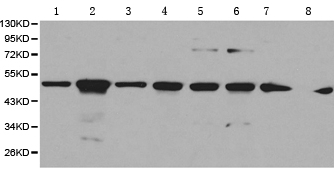Arp3 (ACTR3) Rabbit Polyclonal Antibody
Other products for "ACTR3"
Specifications
| Product Data | |
| Applications | WB |
| Recommended Dilution | WB: 1:500-2000 |
| Reactivities | Human, Mouse, Rat |
| Host | Rabbit |
| Isotype | IgG |
| Clonality | Polyclonal |
| Immunogen | Fusion protein corresponding to C terminal 210 amino acids of human ARP3 actin-related protein 3 homolog (yeast) |
| Formulation | PBS pH7.3, 0.05% NaN3, 50% glycerol |
| Concentration | lot specific |
| Purification | Antigen affinity purification |
| Conjugation | Unconjugated |
| Storage | Store at -20°C as received. |
| Stability | Stable for 12 months from date of receipt. |
| Predicted Protein Size | 47 kDa |
| Gene Name | ARP3 actin-related protein 3 homolog (yeast) |
| Database Link | |
| Background | Actin nucleation, the formation of new actin filaments from existing filaments, affects actin filament structure during cell motility, division, and intracellular trafficking. An important actin nucleation protein complex is the highly conserved ARP2/3 complex, consisting of ARP2, ARP3, and ARPC1-5. The ARP2/3 complex promotes branching of an existing actin filament and formation of a daughter filament following activation by nucleation-promoting factors, such as WASP/WAVE or cortactin. The formation of podosomes, small cellular projections that degrade the extracellular matrix, is enhanced by ARP2/3 complex action. ARP2/3 competes with caldesmon, an actin binding protein shown to negatively affect podosome formation). Along with N-WASP, the ARP2/3 complex regulates nuclear actin filament nucleation and controls actin polymerization during transcription. |
| Synonyms | ARP3 |
| Reference Data | |
| Protein Families | Druggable Genome |
Documents
| Product Manuals |
| FAQs |
{0} Product Review(s)
0 Product Review(s)
Submit review
Be the first one to submit a review
Product Citations
*Delivery time may vary from web posted schedule. Occasional delays may occur due to unforeseen
complexities in the preparation of your product. International customers may expect an additional 1-2 weeks
in shipping.






























































































































































































































































 Germany
Germany
 Japan
Japan
 United Kingdom
United Kingdom
 China
China



